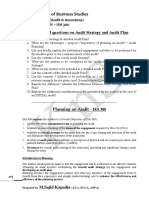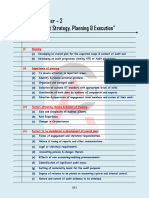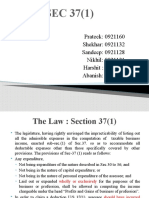2. AUDIT STRATEGY, AUDIT PLANNING AND AUDIT PROGRAMME
2. AUDIT STRATEGY, AUDIT PLANNING AND AUDIT PROGRAMME
Uploaded by
Alfred JosephCopyright:
Available Formats
2. AUDIT STRATEGY, AUDIT PLANNING AND AUDIT PROGRAMME
2. AUDIT STRATEGY, AUDIT PLANNING AND AUDIT PROGRAMME
Uploaded by
Alfred JosephCopyright
Available Formats
Share this document
Did you find this document useful?
Is this content inappropriate?
Copyright:
Available Formats
2. AUDIT STRATEGY, AUDIT PLANNING AND AUDIT PROGRAMME
2. AUDIT STRATEGY, AUDIT PLANNING AND AUDIT PROGRAMME
Uploaded by
Alfred JosephCopyright:
Available Formats
1 AUDITOR’S RESPONSIBILITY TO PLAN AN AUDIT OF FINANCIAL STATEMENTS
SA 300- Planning an audit of financial statements
1.1 Why planning an audit is necessary? - Its Benefits
1. Helping the auditor to devote appropriate attention to important areas of the audit.
2. Helping the auditor identify and resolve potential problems on a timely basis.
3. Helping the auditor properly organize and manage the audit engagement.
4. Assisting in the selection of engagement team members with appropriate levels of
capabilities and competence.
5. Facilitating the direction and supervision of engagement team members.
6. Assisting, where applicable, in coordination of work done by others.
1.2 Nature of Audit Planning- A Continuous and iterative process
Planning includes the need to consider, prior to the auditor’s identification and
assessment of the risks of material misstatement, such matters as:
1. The analytical procedures to be applied as risk assessment procedures.
2. Obtaining a general understanding of the legal and regulatory framework
3. The determination of materiality.
4. The involvement of experts.
5. The performance of other risk assessment procedures.
Involvement of key engagement team members in planning audit
Discussion of elements of planning with entity’s management
2 PLANNING PROCESS - ELEMENTS OF PLANNING
The elements of planning can be categorized as under: -
(I) Preliminary engagement activities
(II) Planning activities
(I) Preliminary engagement activities
CA AMIT TATED AT ACADEMY - MUMBAI AUD - 7
(A) Performing procedures regarding the continuance of the client relationship
(B) Evaluating compliance with ethical requirements, including independence
(C) Establishing an understanding of terms of engagement
(II) Planning activities
Planning activities involve:-
[A] Establishing the overall audit strategy
[B] Developing an audit plan
(A) Establishing the overall audit strategy- Assistance for the auditor
Overall audit strategy sets the scope, timing and direction of the audit, and
guides the development of the more detailed audit plan.
The process of establishing the overall audit strategy assists the auditor to determine,
subject to the completion of the auditor’s risk assessment procedures, such matters as:-
(i) The resources to deploy for specific audit areas
(ii) The amount of resources to allocate to specific audit areas
(iii) When these resources are to be deployed
(iv) How such resources are managed, directed and supervised
The auditor shall take following factors into consideration while establishing audit
strategy:-
(a) Identify the characteristics of the engagement that define its scope
Applicable financial reporting framework applicable to the entity
Nature of business segments to be audited
Industry specific reporting requirements required by industry regulators
Expected use of audit evidence obtained in previous audits
(b) Ascertain the reporting objectives of the engagement
The entity’s timetable for reporting
Organization of meetings to discuss of nature, timing and extent of audit work
Discussion with management regarding the expected type and timing of reports
Discussion with management regarding the expected communications
Expected nature and timing of communications among engagement team members
(c) Consider the factors that, in the auditor’s professional judgment, are significant in
directing the engagement team’s efforts
CA AMIT TATED AT ACADEMY - MUMBAI AUD - 8
Volume of transactions
Significant industry developments
Significant changes in the financial reporting framework
Other significant relevant developments
(d) Consider the results of preliminary engagement activities
(e) Ascertain the nature, timing and extent of resources
(B) Development of Audit plan
SA-300 states that auditor shall develop an audit plan that shall include description of-
(i) The nature, timing and extent of planned risk assessment procedures
(ii) The nature, timing and extent of planned further audit procedures at assertion level
(iii) Other planned audit procedures.
3 RELATIONSHIP BETWEEN AUDIT STRATEGY AND AUDIT PLAN
The establishment of the overall audit strategy and the detailed audit plan are not
necessarily discrete or sequential processes but are closely inter – related
4. OVERALL AUDIT STRATEGY AND THE AUDIT PLAN- THE AUDITOR’S
RESPONSIBILITY
5 CHANGES TO PLANNING DECISIONS DURING THE COURSE OF AUDIT
As a result of unexpected events, changes in conditions, or the audit evidence obtained
from the results of audit procedures, the auditor may need to modify the overall
audit strategy and audit plan.
6 PLANNING SUPERVISION AND REVIEW OF WORK OF ENGAGEMENT TEAM
MEMBERS
1. The size and complexity of the entity.
2. The area of the audit.
3. The assessed risks of material misstatement
4. The capabilities and competence of the individual team members
CA AMIT TATED AT ACADEMY - MUMBAI AUD - 9
7. DOCUMENTATION
(a) the overall audit strategy
(b) the audit plan and
(c) any significant changes made during the audit engagement
8. AUDIT PROGRAMME
An audit programme consists of a series of verification procedures to be applied to
the financial statements and accounts of a given entity for the purpose of obtaining
sufficient evidence to enable the auditor to express an informed opinion on financial
statements.
8.1 Evolving one audit programme- Not Practicable for All businesses
Businesses vary in nature, size and composition;
8.2 The Assistant to keep an open mind
The assistant engaged in the job should be encouraged to keep an open mind beyond
the programme given to him.
8.3 Periodic review of the audit programme
Whether the same continues to be adequate for obtaining requisite knowledge and
evidence.
Many persons believe that this brings an element of rigidity in the audit programme.
This is not true provided the periodic review is undertaken to keep the programme
as up-to- date as possible.
8.4 Constructing an audit programme
For the purpose of programme construction, the following points should be kept in
mind:
(1) Stay within the scope and limitation of the assignment.
(2) Prepare a written audit programme
(3) Determine the evidence reasonably available
(4) Apply only those steps and procedures.
(5) Include the audit objectives
(6) Consider all possibilities of error
(7) Co-ordinate the procedures to be applied to related items.
CA AMIT TATED AT ACADEMY - MUMBAI AUD - 10
8.5 Audit Programme- Designed to provide audit evidence
(a) Documentary examination
(b) Physical examination
(c) Statements and explanation of management, officials and employees
(d) Statements and explanations of third parties
(e) Arithmetical calculations by the auditor
(f) State of internal controls and internal checks
(g) Inter-relationship of the various accounting data
(h) Subsidiary and memorandum records
8.6 Advantages and disadvantages of an audit programme
The advantages of an audit programme are:-
(a) Total and clear set of instructions.
(b) Total perspective of the work to be performed.
(c) Selection of assistants for the jobs.
(d) Without a written and pre-determined programme, there is always a danger of ignoring
or overlooking certain books and records.
(e) The assistants, by putting their signature on programme, accept the responsibility.
(f) The principal can control the progress.
(g) It serves as a guide for audits to be carried out in the succeeding year.
(h) Serves as evidence in the event of any charge of negligence.
The disadvantages are:-
(a) The work may become mechanical and particular parts of the programme may be carried
out without any understanding.
(b) The programme often tends to become rigid and inflexible
(c) Inefficient assistants
(d) A hard and fast audit programme may kill the initiative of efficient
CA AMIT TATED AT ACADEMY - MUMBAI AUD - 11
You might also like
- WoodCorp Inc - Case StudyDocument2 pagesWoodCorp Inc - Case Studylin_guardianangel67% (6)
- Australian Version - Manual and Questionnaires - WHOQOL-100 and BREFDocument89 pagesAustralian Version - Manual and Questionnaires - WHOQOL-100 and BREFMuath100% (2)
- Data Analysis and InterpretationDocument28 pagesData Analysis and InterpretationRESHMANo ratings yet
- E BookDocument5 pagesE BookSavit BansalNo ratings yet
- Isa 300Document11 pagesIsa 300Khurram RashidNo ratings yet
- Audit Notes Ca BosDocument30 pagesAudit Notes Ca BosBijay AgrawalNo ratings yet
- Audit ProgrammeDocument27 pagesAudit ProgrammePrathyusha KorukuriNo ratings yet
- AT Lecture 6 - Planning An Audit of FS June 2020Document8 pagesAT Lecture 6 - Planning An Audit of FS June 2020Sophia TenorioNo ratings yet
- CH 2Document25 pagesCH 2Harsh DaneNo ratings yet
- Combined (1) PagesDocument13 pagesCombined (1) Pagesmohithreddy441No ratings yet
- Chapter+7 Audit+PlanningDocument20 pagesChapter+7 Audit+Planningmohazka hassanNo ratings yet
- Planning An Audit of Financial Statements8888888Document11 pagesPlanning An Audit of Financial Statements8888888sajedulNo ratings yet
- Topic.4b Audit Plan, Audit Programme and Working PapersDocument8 pagesTopic.4b Audit Plan, Audit Programme and Working PapersDANIEL ROBERT MAHENGENo ratings yet
- Isa+300+caf+9Document5 pagesIsa+300+caf+9Mustafa DhedhiNo ratings yet
- Compiler Chapter 2Document13 pagesCompiler Chapter 2cs618477197768No ratings yet
- II - Audit Strategy, PlanningDocument8 pagesII - Audit Strategy, PlanningAlphy maria cherianNo ratings yet
- Audit Planning AnswersDocument3 pagesAudit Planning AnswersKathlene BalicoNo ratings yet
- Statement of Auditing StandardsDocument2 pagesStatement of Auditing StandardsMikaela SalvadorNo ratings yet
- Audit Module 2 - Audit Planning PDFDocument25 pagesAudit Module 2 - Audit Planning PDFTanishq RastogiNo ratings yet
- Auditing Notes by Rehan Farhat ISA 300Document21 pagesAuditing Notes by Rehan Farhat ISA 300Omar SiddiquiNo ratings yet
- Project On Audit Plan and Programme & Special AuditDocument11 pagesProject On Audit Plan and Programme & Special AuditPriyank SolankiNo ratings yet
- 1.5 Iacop Audit Planning Guidance 3 06 18Document16 pages1.5 Iacop Audit Planning Guidance 3 06 18lakshman1234sterNo ratings yet
- Auditing 2Document13 pagesAuditing 2divyakiruba10lawNo ratings yet
- W3 Lesson 3 Audit PlanningDocument7 pagesW3 Lesson 3 Audit PlanningbeadcpagarNo ratings yet
- Audit Programme 2020-2021Document41 pagesAudit Programme 2020-2021Samarth SahuNo ratings yet
- What Is The General Objective of Planning For An Audit?Document2 pagesWhat Is The General Objective of Planning For An Audit?FuturamaramaNo ratings yet
- Chp-2 QuestionsDocument10 pagesChp-2 Questionssatgup78No ratings yet
- CM 1 (GAAS & Planning)Document4 pagesCM 1 (GAAS & Planning)Gab GabNo ratings yet
- AASI302 MidtermLesson1Document22 pagesAASI302 MidtermLesson1guerrerojamesssNo ratings yet
- Audit PlanningDocument4 pagesAudit Planningmohammad faraz aliNo ratings yet
- Bos 34430 SMCP 2Document12 pagesBos 34430 SMCP 2remtluangachhangte7No ratings yet
- Chapter 2. Asuncion HandoutDocument8 pagesChapter 2. Asuncion HandoutCiel ArvenNo ratings yet
- Audit Programme 1Document27 pagesAudit Programme 1I am JacobNo ratings yet
- Chp-2 AUDIT STRATEGY, AUDIT PLANNING AND AUDITDocument20 pagesChp-2 AUDIT STRATEGY, AUDIT PLANNING AND AUDITsatgup78No ratings yet
- Day 2 TC On ISO 19011 2018Document60 pagesDay 2 TC On ISO 19011 2018Twinkle MiguelNo ratings yet
- Auditing 1.2 Phase4Document10 pagesAuditing 1.2 Phase4MarcNo ratings yet
- Activity 4Document12 pagesActivity 4Beatrice Ella DomingoNo ratings yet
- Lecture 4a Auditing Procedures and Techniques - Zainab HasanDocument22 pagesLecture 4a Auditing Procedures and Techniques - Zainab HasanalooyxvNo ratings yet
- CH2Document14 pagesCH2rcrrv6x68wNo ratings yet
- Session 6 PlanningDocument64 pagesSession 6 Planningmbangumilu15No ratings yet
- Stages of An AuditDocument4 pagesStages of An AuditDerrick KimaniNo ratings yet
- Planning and Risk AssessmentDocument13 pagesPlanning and Risk AssessmentLakmal KaushalyaNo ratings yet
- Reviewer Sa AuditDocument6 pagesReviewer Sa Auditprincess manlangitNo ratings yet
- Lecture 3 Audit Planning and Internal ControlDocument20 pagesLecture 3 Audit Planning and Internal ControlKaran RawatNo ratings yet
- Audit Planning and DocumentationDocument46 pagesAudit Planning and Documentationjeffery.owusu.nanaNo ratings yet
- Unit 3: Basic Concepts of AuditingDocument13 pagesUnit 3: Basic Concepts of AuditingYonasNo ratings yet
- 6 - Audit PlanningDocument17 pages6 - Audit PlanningJayson Manalo Gaña100% (1)
- Iso 19011-2Document11 pagesIso 19011-2gokij48848No ratings yet
- Unit 3: Basic Concepts of AuditingDocument12 pagesUnit 3: Basic Concepts of Auditingembiale ayaluNo ratings yet
- Ca Audit 2023 Unit IiDocument11 pagesCa Audit 2023 Unit IiAntrew B2No ratings yet
- Advanced Audit and Assurance 5Document22 pagesAdvanced Audit and Assurance 5k20b.lehoangvuNo ratings yet
- Chapter 2-Audit Stategy Audit Planing and Audit ProgrammeDocument34 pagesChapter 2-Audit Stategy Audit Planing and Audit Programmeabhichavan7722100% (1)
- C2 Inter AuditDocument8 pagesC2 Inter Auditbroabhi143No ratings yet
- GRP II - Auditing (N) - Suggested Ans - Nov 2018Document15 pagesGRP II - Auditing (N) - Suggested Ans - Nov 2018ABC LtdNo ratings yet
- Audit ProgrammeDocument2 pagesAudit ProgrammeShruti SehgalNo ratings yet
- 07 FS Audit Process - Audit PlanningDocument6 pages07 FS Audit Process - Audit Planningrandomlungs121223No ratings yet
- Ch-2 Audit PlanningDocument3 pagesCh-2 Audit PlanningSavya Sachi100% (1)
- Best Practice in QC AuditDocument6 pagesBest Practice in QC AuditMoatz HamedNo ratings yet
- Auditing and Assurance Speclized Industries - 18 Sep 2023Document29 pagesAuditing and Assurance Speclized Industries - 18 Sep 2023Renelyn FiloteoNo ratings yet
- Chapter - 2 "Audit Strategy, Planning & Execution": Lecture - 18Document6 pagesChapter - 2 "Audit Strategy, Planning & Execution": Lecture - 18Aruna RajappaNo ratings yet
- CHAPTER5Document8 pagesCHAPTER5Anjelika ViescaNo ratings yet
- At 05 - Auditor PlanningDocument8 pagesAt 05 - Auditor PlanningRei-Anne ReaNo ratings yet
- Between 1. Name of The Executant (Lessor) :-Sri/Smt. ................................ (Aged AboutDocument6 pagesBetween 1. Name of The Executant (Lessor) :-Sri/Smt. ................................ (Aged AboutNiru MathurNo ratings yet
- AC DC Railway Electrification and Protection: November 2014Document43 pagesAC DC Railway Electrification and Protection: November 2014Akhilesh kumar Srivastava100% (1)
- Lecture 04 - Continuous System SimulationDocument8 pagesLecture 04 - Continuous System SimulationmosqNo ratings yet
- RTD Regional BRT Feasibility StudyDocument93 pagesRTD Regional BRT Feasibility StudyShohel Rana TituNo ratings yet
- Group Members:: Ambily.J.Xavier Alka.G.Pillai Naveen Anil Browny Jinu PrakashDocument51 pagesGroup Members:: Ambily.J.Xavier Alka.G.Pillai Naveen Anil Browny Jinu PrakashNaveenAnilNo ratings yet
- Titas Gas Transmission and Distribution Company Limited: Meter S/N: 2021500002Document2 pagesTitas Gas Transmission and Distribution Company Limited: Meter S/N: 2021500002tareq.sefatNo ratings yet
- Courts On Trial: Myth and Reality in American Justice, by Jerome FrankDocument7 pagesCourts On Trial: Myth and Reality in American Justice, by Jerome FrankSHUMETNo ratings yet
- Pelaksanaan Penilaian Autentik Pada Mata Pelajaran Ekonomi Di Sma Negeri Se-Kabupaten Ogan IlirDocument8 pagesPelaksanaan Penilaian Autentik Pada Mata Pelajaran Ekonomi Di Sma Negeri Se-Kabupaten Ogan IlirShafwani FithriNo ratings yet
- Anern Integrated Solar Street Light (AN-ISSL-M) - 201604Document3 pagesAnern Integrated Solar Street Light (AN-ISSL-M) - 201604Godofredo VillenaNo ratings yet
- Arbitration Set 5Document82 pagesArbitration Set 5John Adrian MaulionNo ratings yet
- Regulatory Guide 1.90Document23 pagesRegulatory Guide 1.90Luis Juan Trejo CruzNo ratings yet
- Emailing 3nethra - Neo - Brochure PDFDocument6 pagesEmailing 3nethra - Neo - Brochure PDFMrunali PatilNo ratings yet
- DETECTORDocument4 pagesDETECTORJuan Luis Mamani SirpaNo ratings yet
- American Wire VS Director of PatentsDocument3 pagesAmerican Wire VS Director of Patentssamaral bentesinkoNo ratings yet
- SA2003-000019 A en Trip Circuit Supervision With RXMB 1 Auxiliary RelayDocument1 pageSA2003-000019 A en Trip Circuit Supervision With RXMB 1 Auxiliary RelayErmin FazlicNo ratings yet
- SymsciDocument24 pagesSymsciDhruv MishraNo ratings yet
- Assignment About Shipboard Computer System by GapoyDocument11 pagesAssignment About Shipboard Computer System by GapoyFrednixen Bustamante GapoyNo ratings yet
- Uff23 Media Partnership ProposalDocument6 pagesUff23 Media Partnership Proposalrifqizaidann20No ratings yet
- Prateek: 0921160 Shekhar: 0921132 Sandeep: 0921128 Nikhil: 0921121 Harshit: 0921114 Abanish: 0921101Document32 pagesPrateek: 0921160 Shekhar: 0921132 Sandeep: 0921128 Nikhil: 0921121 Harshit: 0921114 Abanish: 0921101sandeeplasodNo ratings yet
- Lums Career Services Office: Vacancy Announcement FormDocument4 pagesLums Career Services Office: Vacancy Announcement FormZara RamisNo ratings yet
- Syria ResolutionDocument4 pagesSyria ResolutionUK Mission to the UN100% (1)
- $16.7 Million To Save One Reputation - How Starbucks Responded AmiDocument16 pages$16.7 Million To Save One Reputation - How Starbucks Responded AmiPhuc HoangNo ratings yet
- Partbook SST150 - T1P004Document94 pagesPartbook SST150 - T1P004Ilham HermansahNo ratings yet
- Walker v. Griffin's Heirs, 24 U.S. 375 (1826)Document3 pagesWalker v. Griffin's Heirs, 24 U.S. 375 (1826)Scribd Government DocsNo ratings yet
- Open Ended Lab Star DeltaDocument8 pagesOpen Ended Lab Star Deltaali hamzaNo ratings yet
- Ash'Sharqiyah Sands Water Supply SchemeDocument19 pagesAsh'Sharqiyah Sands Water Supply SchemekerdiziyedNo ratings yet
























































































